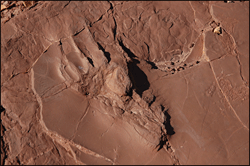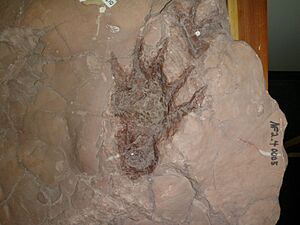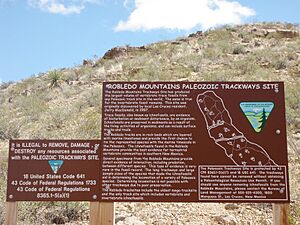Prehistoric Trackways National Monument facts for kids
Quick facts for kids Prehistoric Trackways National Monument |
|
|---|---|
 |
|
| Location | Doña Ana County, NM, USA |
| Nearest city | Las Cruces, New Mexico |
| Area | 5,255 acres (2,127 ha) |
| Established | March 30, 2009 |
| Governing body | Bureau of Land Management |
| Website | Prehistoric Trackways National Monument |
The Prehistoric Trackways National Monument is a special protected area in the Robledo Mountains of New Mexico, United States. It's close to the city of Las Cruces. This monument covers about 5,255 acres of land. It is famous for its amazing fossils from the Paleozoic Era.
This national monument is managed by the Bureau of Land Management. It became the 100th active U.S. national monument on March 30, 2009. It's a fantastic place to learn about ancient life!
Contents
Ancient Footprints and Fossils
This monument is home to a huge collection of fossilized footprints. These are called "fossil trackways." You can find tracks left by land animals, sea creatures, and even insects. These types of fossils are known as trace fossils or ichnofossils. They show us what ancient creatures did, not just what they looked like.
You can also find fossilized plants and petrified wood here. There are many fossils of sea animals without backbones. These include brachiopods (shellfish), gastropods (snails), cephalopods (like ancient squid), bivalves (clams), and echinoderms (like sea stars). Most of these fossils are from the Permian Period. This means they are around 280 million years old!

Some of the creatures that might have left tracks in the Robledo Mountains include Dimetrodon, Eryops, and Edaphosaurus. These were ancient reptiles and amphibians. There are at least 13 main types of trace fossils found here. Some cool names for these tracks are:
- Selenichnites (sel-EEN-ick-NIGHT eez): These are moon-shaped traces.
- Kouphichnium (koof-ICK-nee-um): This means "light trace."
- Palmichnium (pal-ICK-nee-um): This looks like a palm frond.
- Octopodichnus (oct-toe-pod-ICK-nuss): This means "eight-footed trace."
- Lithographus (lith-oh-GRAFF-us): This means "rock writing."
- Tonanoxichnus (tong-a-nox-ICK-nuss): Named after a place in Kansas.
- Augerinoichnus (aw-gurr-EE-no-ICK-nuss): Named after a type of drill.
- Undichna (und-ICK-nuh): These are wave-shaped traces.
- Serpentichnus (serpent-ICK-nuss): These look like snake trails.
- Batrachichnus (baa-track ICK-nuss): This means "frog trace."
- Dromopus (dro-MOE-puss): This means "running foot."
- Dimetropus (die-MEET-row-puss): This is a Dimetrodon foot track.
It can be tricky for visitors to find the trackways on their own. The monument doesn't have many visitor facilities yet. Many of the large fossil slabs found by Jerry MacDonald are kept at the New Mexico Museum of Natural History and Science. You can sometimes join guided hikes led by staff from the Bureau of Land Management.
Geology of the Area
The monument is located in the western part of the Rio Grande rift. This is a large crack in the Earth's crust. The area is made up of rocks from the Cenozoic and Paleozoic eras. The older rocks are part of something called the Hueco Group. These rocks are from the Early Permian period.
Most of the monument's land was once underwater or along the coast of an ancient sea. This sea was called the Hueco Seaway. The fossil tracks are found in red rocks. These rocks are known as the "abo red beds."
Plants and Animals
The monument is at the northern edge of the Chihuahuan Desert. You can see many desert plants here. Some examples include:
- Ocotillo
- Mesquite
- Creosote bush
- Prickly-pear cactus
- Torrey yucca
- Barrel cactus
- Sotol
- Agave
- Snakeweed
You might also spot some animals living in the monument. These include:
- Mule deer
- Rattlesnakes
- Desert cottontail (a type of rabbit)
- Many kinds of lizards
- Several types of birds
Weather in the Monument
The weather here changes throughout the year. January is usually the coolest month. The average high temperature is about 57°F (14°C). June is the hottest month, with average highs around 94°F (34°C). August is the wettest month, getting about 2.52 inches (6.4 cm) of rain.
How the Tracks Were Found
The amazing Paleozoic Era tracks were first found on June 6, 1987. A man named Jerry Paul MacDonald discovered them. People had found scattered footprints in the Robledo Mountains for almost 50 years before Jerry started looking. He talked to local hikers and fossil hunters to figure out where to search.
The first place he found tracks was named the "Discovery Site." This is one of the best spots for visitors to see the fossilized tracks. Jerry MacDonald worked hard to dig out three long trackways. He carried over 2,500 rock slabs from the site on his back!
Most of these slabs are now at the New Mexico Museum of Natural History and Science. They are part of the Jerry MacDonald Paleozoic Trackways Collection. Two other continuous trackways are kept at the Carnegie Museum of Natural History and the Smithsonian.
Becoming a National Monument
The idea to make Prehistoric Trackways a national monument was supported by Senators Jeff Bingaman and Pete Domenici from New Mexico. It became part of the National Landscape Conservation System of the United States.
The monument was officially created on March 30, 2009. This happened when the Omnibus Public Land Management Act was signed into law. It was the first national monument established during the Barack Obama administration. It was also the fourth national monument created in 2009. At that time, it became the 100th active national monument in the United States.
Things to Do
The Bureau of Land Management is still working on a plan for the monument. This plan will help decide how to manage the area. For now, there are no special hiking or horse trails that have been built. There is only one sign that explains things to visitors.
The roads are not kept up, and there are no visitor facilities like restrooms or water. However, there are trails for off-highway vehicles (OHVs) and mountain bikes. These trails are very rough, so you need the right skills and equipment to use them.



